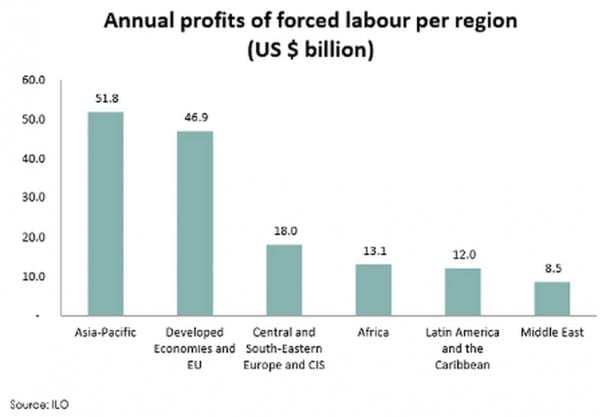Some 21 million women, men and children are in forced labor, trafficked, held in debt bondage or work in slave-like conditions worldwide, and their toil generates an estimated $150 billion in illegal profits in the private global economy, according to a new report by the International Labor Organization (ILO). The $150 billion in illegal profits is three times more than the previous ILO estimate.
he majority of those in forced labor are women and girls, who make up 55 percent of the total, compared with 9.5 million (45 percent) men and boys. Many of these women are domestic workers. Of the 52.6 million domestic workers worldwide, the report estimates 3.4 million—6.5 percent—are in forced labor. Further, many domestic workers are migrants, often exploited by labor brokers and employers. The report notes that an estimated $8 billion is literally stolen annually from domestic workers in forced labor who, on average, are effectively deprived of 60 percent of their wages.
Overall, $51 billion of the estimated $150 billion in illegal profits results from forced economic exploitation, including domestic work and agriculture, areas where women make up much or most of the workforce. Commercial sexual exploitation accounts for $99 billion.
“Profits and Poverty: The Economics of Forced Labor” finds solid evidence for a correlation between forced labor and poverty. In countries where the ILO measured “income shocks” and food insecurity, such as Niger and Bolivia, a larger percentage of forced laborers than people who worked freely came from households where income had declined. In Nepal, only 9 percent of workers in forced labor had lived in food-secure households, compared with 56 percent of freely employed individuals.
The report finds the profit from forced labor is generated from three broad areas:
• $34 billion in construction, manufacturing, mining and utilities.
• $9 billion in agriculture, including forestry and fishing.
• $8 billion saved by private households by not paying or underpaying domestic workers held in forced labor.
An individual is considered to be working in forced labor, according to the ILO’s survey guidelines, if his or her recruitment was not free and involved some form of penalty at the time of recruitment, and if that individual works and lives under duress, and faces any penalty or cannot leave the employer because of the menace of a penalty.
• Read a summary of the report.
• Read the full report.
• In this video, ILO Director General Guy Ryder urges immediate action to end forced labor.

